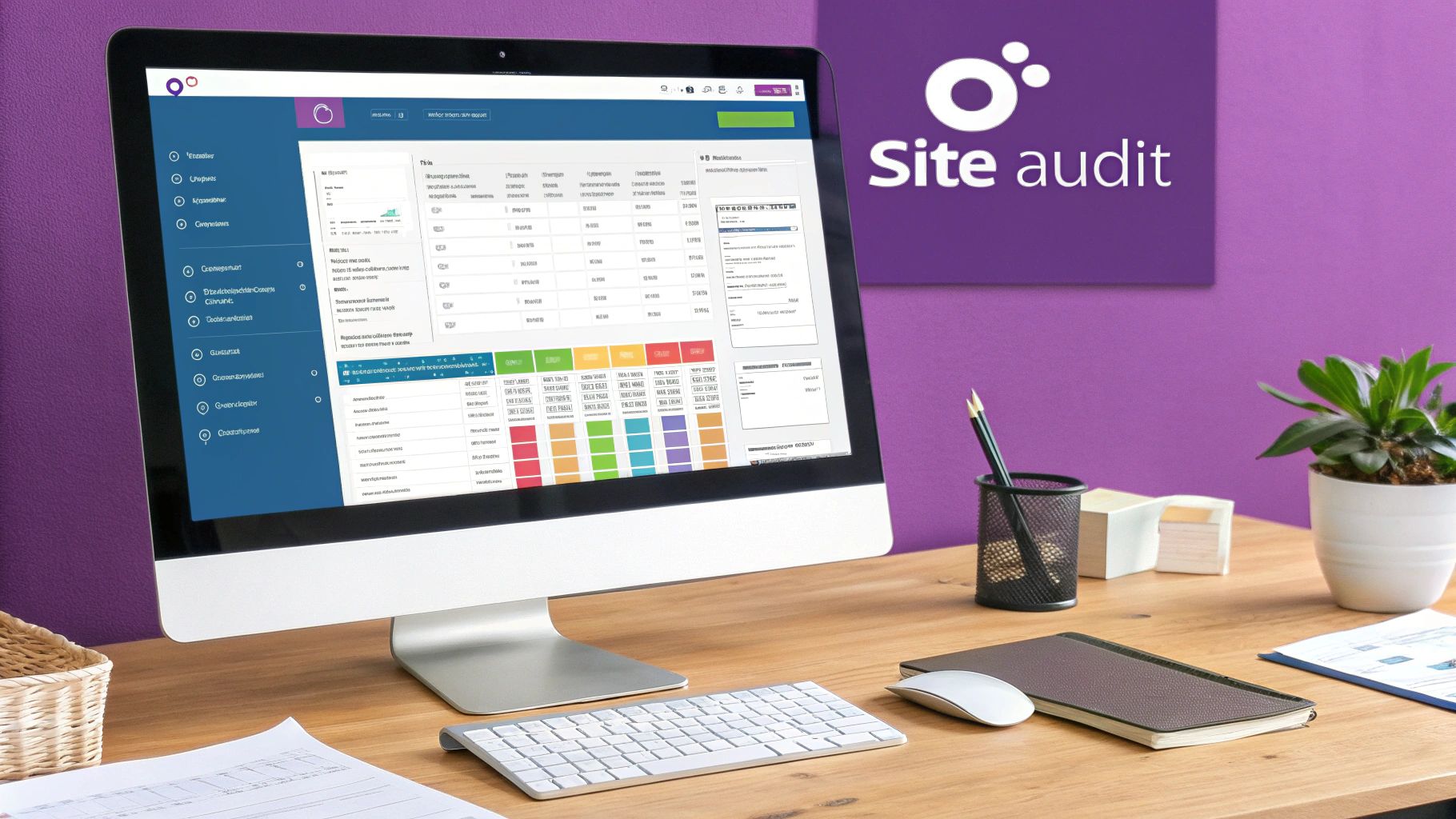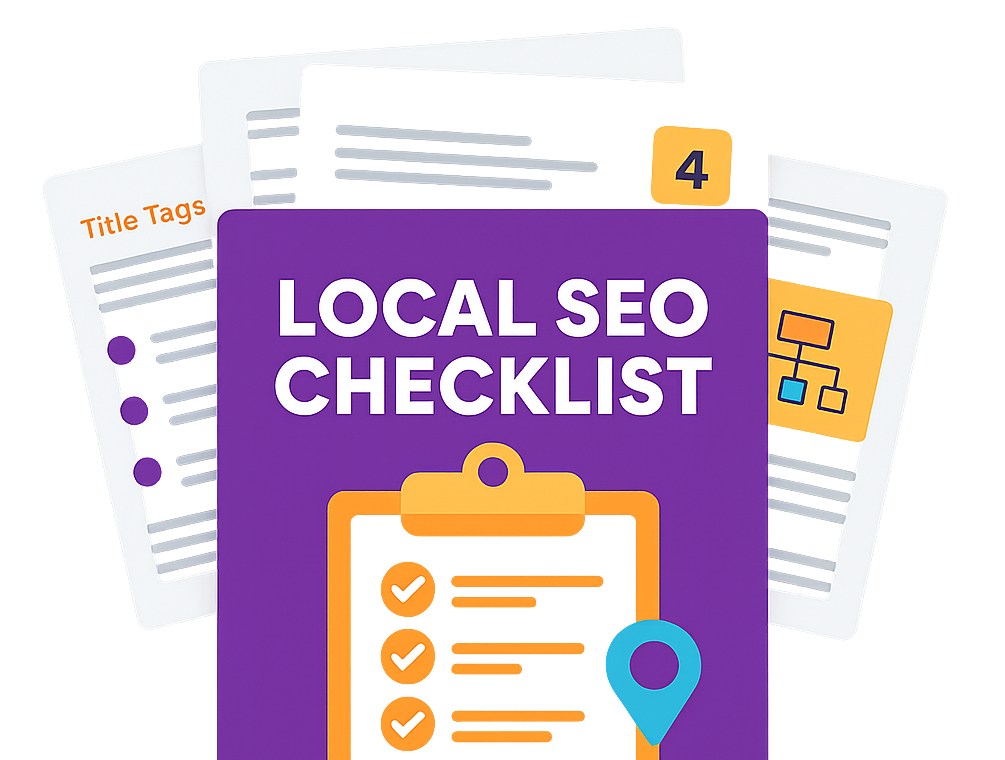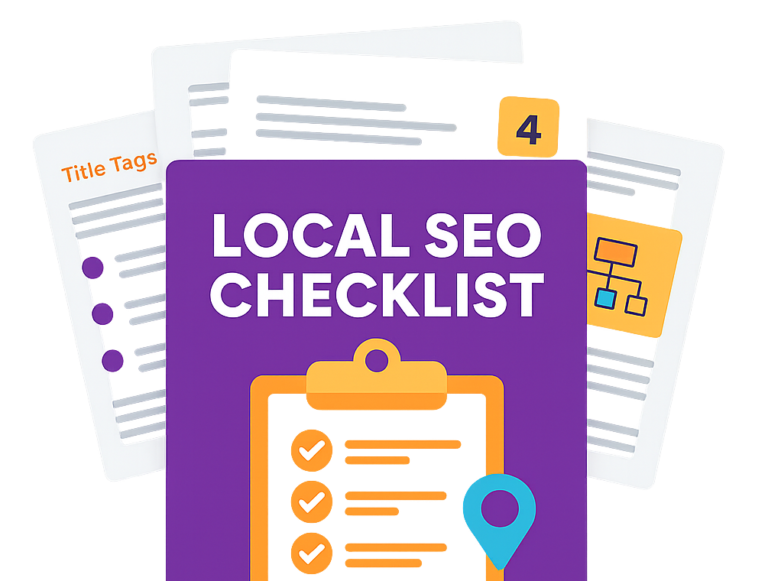Technical SEO services are all about optimising the bits of your website that visitors don't see—the 'under-the-bonnet' stuff. The goal is to make it incredibly easy for search engines to find, understand, and ultimately rank your site. Think of it as building a rock-solid foundation for your entire online presence, focusing on structure, speed, and how easily search engines can crawl it, rather than the content itself.
What Are Technical SEO Services, Really?

Let’s use an analogy. Imagine your website is a high-performance car. Your content is the powerful engine, and your design is the sleek, eye-catching bodywork. But what if the chassis is weak, the wiring is a mess, or the wheels are misaligned? It doesn’t matter how powerful that engine is or how beautiful the car looks; it’s never going to perform properly.
This is exactly where technical SEO services step in. They’re the essential, behind-the-scenes engineering that ensures the car's core framework is flawless. Technical SEO isn't about the words on your pages or the colours you choose; it's about the very foundation your website is built on.
The Foundation of Digital Visibility
At its heart, technical SEO answers one crucial question: can search engines like Google actually access and make sense of your website? If the answer is no, then all your other marketing efforts—from brilliant blog posts to clever social media campaigns—are built on shaky ground.
To get this right, a good technical SEO strategy focuses on a few core pillars. We've laid out the most critical ones in the table below to show you what they are and, more importantly, why they matter for your business.
Core Components of Technical SEO Services
| Technical SEO Component | What It Is | Why It Matters for Your Business |
|---|---|---|
| Crawlability | A search engine’s ability to explore your entire website without hitting dead ends or blocked paths. | If Google's "spiders" can't find your pages, they're invisible. Good crawlability ensures every important page has a chance to rank. |
| Indexability | The process of a crawled page being added to Google’s massive library, or "index." | A page that isn't indexed simply cannot appear in search results. It’s like a book that never makes it to the library shelf—no one will find it. |
| Site Architecture | The logical structure of your website and how pages link to one another. | A clean structure makes it easy for both users and search engines to navigate, signalling which pages are most important and improving user experience. |
| Page Speed | How quickly the content on your pages loads for a visitor. | Slow sites frustrate users and lead to high bounce rates. Google prioritises faster sites, so speed directly impacts your rankings and conversions. |
| Mobile-Friendliness | Ensuring your website provides a seamless experience on smartphones and tablets. | With over half of web traffic coming from mobile, a poor mobile site alienates a huge chunk of your audience and hurts your search performance. |
| Site Security (HTTPS) | Using encryption to secure the connection between a user's browser and your website. | Google flags non-secure sites, which damages user trust and rankings. A secure site is now a non-negotiable standard. |
These elements aren't just technical tick-box exercises; they have a direct and measurable impact on how customers find and interact with your business online.
A technically sound website is a non-negotiable part of any digital strategy. It’s the groundwork that makes all other SEO and content marketing activities possible, directly impacting how easily search engines and customers find and use your website.
Beyond Just Being Found
While making sure your site can be found is the first hurdle, professional technical SEO services go much deeper. They’re really about optimising the user experience, which has become a massive ranking factor for Google. After all, a site that’s slow, confusing, or insecure offers a poor experience, and Google doesn't want to send its users there.
This means fine-tuning everything from page speed, so you don’t lose impatient visitors, to guaranteeing a flawless mobile experience, since over half of all web traffic now comes from mobile devices. This "under-the-bonnet" work is what sets the stage for sustainable growth, turning a functional website into a high-performing digital asset that drives rankings, traffic, and revenue.
Why Your Business Cannot Afford to Ignore Technical SEO
It’s easy to look at technical SEO services and see them as just another business cost. I've seen many companies make this mistake. But in reality, it's a vital investment with real, measurable returns. Neglecting your website's technical health is like having a slow puncture in your car's tyre—you might not notice it at first, but eventually, it will leave you stranded while your competitors speed right past.
The fallout from ignoring this stuff can be severe, hitting your bottom line directly. Slow loading times? They’re a notorious conversion killer; potential customers will simply give up and leave. A clunky mobile experience can drive away more than half of your audience. Even worse, indexing errors can make your most important pages completely invisible to Google. You could have the best product on the market, but it’s all for nothing if people can't find or use your site.
Turning Technical Health into Business Growth
A website that’s technically sound does more than just keep search engines happy. It makes life better for your users. When people have a smooth, fast, and intuitive experience on your site, they stick around longer, read more of your content, and are far more likely to become paying customers. This kind of positive engagement sends powerful signals back to Google, helping to lower your bounce rates and boost your rankings over time.
Investing in technical SEO is also about future-proofing your business. Google is constantly updating its algorithm, with a growing emphasis on site performance, security, and usability. A solid technical foundation means your website can weather these inevitable changes, protecting your hard-won rankings and traffic from sudden drops.
For UK businesses in a crowded digital marketplace, a fast, reliable, and secure website isn't just a nice-to-have. It’s a direct reflection of your brand's credibility and professionalism—a powerful advantage that builds genuine customer trust.
A Smart Investment with Measurable Returns
The financial case for technical SEO is incredibly compelling. More and more UK businesses are realising its value, especially when you look at the return on investment. Industry benchmarks show an impressive average ROI of 117% for technical SEO initiatives, a figure that leaves many other marketing channels in the dust.
What’s more, the payback is much quicker. Technical SEO can break even about a third faster than thought leadership content and almost 60% faster than basic content marketing. This makes it a particularly smart move for businesses that need to see results without a long wait. You can explore more about these SEO statistics to get the full picture.
Ultimately, ignoring the technical health of your website is just leaving money on the table. Solidifying your site’s foundation through professional technical SEO services isn't an expense; it's one of the most effective investments you can make for sustainable growth and revenue.
How a Technical SEO Audit Uncovers Hidden Issues
Think of technical SEO services as a full health MOT for your website. An audit is the diagnostic stage, the part where a specialist lifts the bonnet and inspects the engine to find all the hidden faults that are quietly hurting your rankings and frustrating your visitors.
An expert will fire up powerful tools like Google Search Console and crawling software such as Screaming Frog to perform a deep dive into your site's architecture. This process maps out every single URL, image, and file, essentially creating a complete inventory of your digital property. It's from this comprehensive blueprint that the real work begins.
The Phases of a Technical Audit
A proper audit isn't just a quick scan. It's a methodical investigation broken down into distinct phases, with each step building on the last to deliver a clear, actionable report.
-
Phase 1: Data Gathering: The first step is a deep crawl of the entire website. This is where tools map out every page, see how they all link together, and flag initial errors like broken links or server problems.
-
Phase 2: Analysis and Diagnosis: With all the data collected, the focus shifts to analysis. Here, an expert digs into critical areas like page speed, mobile-friendliness, site security, and whether Google is even indexing your pages properly. They pinpoint exactly what's wrong and, more importantly, why it's happening.
-
Phase 3: Prioritisation and Reporting: Finally, all the findings are compiled into a prioritised action plan. This isn't just a long list of problems; it’s a strategic roadmap. It tells you what's broken, how badly it's hurting you, and the most logical order to fix things for the biggest impact.
This final report is the foundation for all future optimisation work. For a more detailed look at what goes into this process, you can check out our technical SEO audit checklist with 15 essential elements.
From Code to Clarity
A crucial part of any modern audit is checking a site's structured data. This is special code embedded in your pages that helps search engines make sense of your content—like identifying a recipe, a product review, or a local business's opening hours.

The image above gives you an idea of what clean, well-formed structured data looks like. Getting this right is what helps your site stand out in search results with eye-catching rich snippets.
An audit transforms complex technical data into a clear, prioritised set of instructions. It's the difference between guessing what might be wrong and knowing exactly what to fix to improve performance.
Without a thorough audit, any attempt at SEO is just a shot in the dark. It provides the evidence-based foundation you need to make sure your investment in technical SEO services actually delivers tangible results.
Right, let's break down what a powerful technical SEO strategy actually looks like day-to-day. While a one-off audit gives you a fantastic starting point—a map, if you will—real, lasting success comes from treating technical SEO as an ongoing process. It’s built on a few core pillars that need constant attention to keep your website in fighting shape.
Think of it like keeping a high-performance car tuned. You don't just fix it when it breaks down; you perform regular maintenance to ensure it's always running at its absolute best. A truly effective strategy isn't just about patching up errors. It's about optimising the fundamental building blocks that define how both people and search engines see your website.
Here are the critical pillars that transform those technical tweaks into better rankings and, ultimately, more business.
Site Speed and Core Web Vitals
In the cut-throat world of e-commerce and lead generation, speed isn’t just a feature; it's everything. We’ve moved beyond simply asking "does my site feel fast?". Google now measures very specific user experience metrics, which it calls Core Web Vitals. These look at how quickly your page loads, how soon someone can interact with it, and whether the layout jumps around as it loads.
A delay of a few milliseconds can genuinely be the difference between a sale and a bounce. For your visitors, a slow site is just plain frustrating and often signals a low-quality or untrustworthy business. For search engines, it's a direct ranking factor. Fast, responsive websites get rewarded with better visibility. Slow ones get left behind. It's as simple as that.
Mobile-First Optimisation
The way we all browse the internet has completely changed. The vast majority of online traffic now comes from mobile devices, which is exactly why Google switched to mobile-first indexing. This means Google primarily looks at the mobile version of your website to decide how to rank it.
What does this mean for you? A flawless mobile experience is no longer a "nice-to-have"—it's the absolute baseline. This is about more than just having a site that shrinks to fit a smaller screen. It demands:
- Responsive Design: Your site must look and work perfectly on every screen, from the smallest smartphone to the largest tablet.
- Touch-Friendly Navigation: Buttons and links need to be big enough to tap easily, with enough space around them to prevent frustrating "fat-finger" mistakes.
- Optimised Performance: Mobile internet connections aren't always stable. Your mobile pages need to be exceptionally light and load in a flash.
A flawless mobile website is non-negotiable. If your site doesn’t work perfectly on a smartphone, you’re not just providing a poor experience—you are actively hurting your chances to rank in search results.
Smart Site Architecture and Internal Linking
Picture your website as a library. A logical site architecture acts like a well-organised set of shelves and clear signs, guiding visitors effortlessly to the information they're looking for. For search engines, this structure provides a clear map, helping them understand the hierarchy and relative importance of all your pages.
Strong internal linking is what holds this entire structure together. By linking logically between relevant pages, you help search engine crawlers find all your important content. Even better, you pass authority (sometimes called 'link equity') from your strongest pages to others, giving them a much-needed boost in the rankings. To stay on top of your game, it's vital to keep up with the latest shifts, and you can get a great overview by exploring the latest SEO trends for 2023 in our detailed guide.
Schema Markup
Schema markup is essentially a special vocabulary that you add to your website's code to help search engines understand your content on a deeper level. It’s like adding labels to your information. For instance, you can explicitly tell Google that a string of numbers is a phone number, a block of text is a customer review, or that a specific page is about a product with a certain price and stock level.
When you implement schema correctly, you help your site earn rich snippets in the search results. These are the enhanced listings you see with star ratings, prices, or event dates right there on the results page. They are far more eye-catching, leading to much higher click-through rates and giving you a direct edge over your competitors.
Choosing the Right Technical SEO Partner in the UK

Picking the right partner for your technical SEO services is a huge decision. It’s one that can genuinely make or break your online success. This isn't just about hiring an agency; it’s about finding a partner you can trust, one who becomes an extension of your own team and is committed to building a rock-solid foundation for your website.
Your choice has a direct impact on both your budget and your results, so you have to evaluate potential partners carefully. This is especially true for small and medium-sized businesses, where every pound spent needs to deliver real, measurable value. To find the right fit, you need to know what to ask and how to spot the red flags before you sign on the dotted line.
Vetting Potential SEO Agencies
When you start talking to agencies, you need to look past the sales pitch. Your real goal is to get a feel for their process, their experience, and how they actually measure success. Any partner worth their salt will be transparent and lean heavily on data to back up their claims.
Here are a few essential questions to get you started:
- Experience: Can you show me some case studies or examples of websites you’ve optimised in our industry?
- Process: How do you decide which technical fixes to tackle first? What’s your reporting process like, and how often will we hear from you?
- Tools: What tools do you rely on for auditing, monitoring, and reporting on technical SEO performance?
A solid proposal should give you clear deliverables, realistic timelines, and transparent pricing. Be very wary of any agency that guarantees a number one ranking on Google. That’s a massive red flag, as no one can ethically promise specific positions.
Understanding Costs and Value
The money flowing into SEO in the UK is pretty substantial. In 2025, the European SEO market is expected to be worth around £22 billion. The UK makes up 13.26% of that, which works out to about £2.9 billion spent each year. This really highlights how competitive the UK market is and why having the right technical expertise is so vital.
Costs for technical SEO services can swing from a few hundred pounds a month to several thousand. For businesses with a tighter budget, finding an agency that offers genuine value is everything. Our guide on affordable SEO services for small businesses offers some great insights into getting the most for your money.
Your Questions on Technical SEO Answered
Even after getting your head around the basics, it’s completely normal to have questions about how technical SEO services actually fit into your business. To help clear things up, we’ve put together answers to some of the most common queries we hear from business owners across the UK.
How Long Does Technical SEO Take to Show Results?
While some quick fixes can give you a nice little boost, real, lasting results take time. For example, sorting out a critical indexing error might get you better visibility within a few weeks. Simple.
But for the bigger stuff, like a major site speed overhaul, you're typically looking at 3-6 months before you see that work properly translate into higher rankings and more organic traffic. Think of technical SEO as a long-term investment in your website's health, not an overnight magic trick.
Is Technical SEO a One-Time Fix?
It’s a bit of both, really. A deep-dive audit followed by a big initial project can fix a whole load of long-standing problems and give you a massive upfront lift.
But websites are living things. You add new content, plugins get updated, and search engine algorithms are always on the move. That’s why ongoing monitoring and a bit of regular maintenance are so important for keeping your results strong and staying one step ahead of the competition.
Technical SEO is a blend of initial large-scale improvements and continuous fine-tuning. The initial phase builds a strong foundation, while ongoing work ensures that foundation remains solid as your digital presence grows.
What Is the Difference Between Technical and On-Page SEO?
Here’s a simple way to think about it. Technical SEO is the plumbing and wiring of your website—the infrastructure. It's all about making sure the site's backend is optimised so search engines can crawl and index it properly. This covers things like site speed, mobile-friendliness, and sitemaps.
On-page SEO, on the other hand, is about the content on individual pages. It focuses on optimising things like your page titles, headings, and how you use keywords to make each page super relevant for specific searches. Both are absolutely essential and need to work together to get you the best results.
The lines are also getting a bit blurry with the rise of machine learning. You can learn more about how to get ready for that shift by reading our guide on using AI for SEO.
Ready to build a stronger foundation for your website? At Bare Digital, we provide expert technical SEO services that drive real growth. Contact us today for your free, no-obligation SEO Health Check and a tailored activity plan. https://www.bare-digital.com
Article created using Outrank








